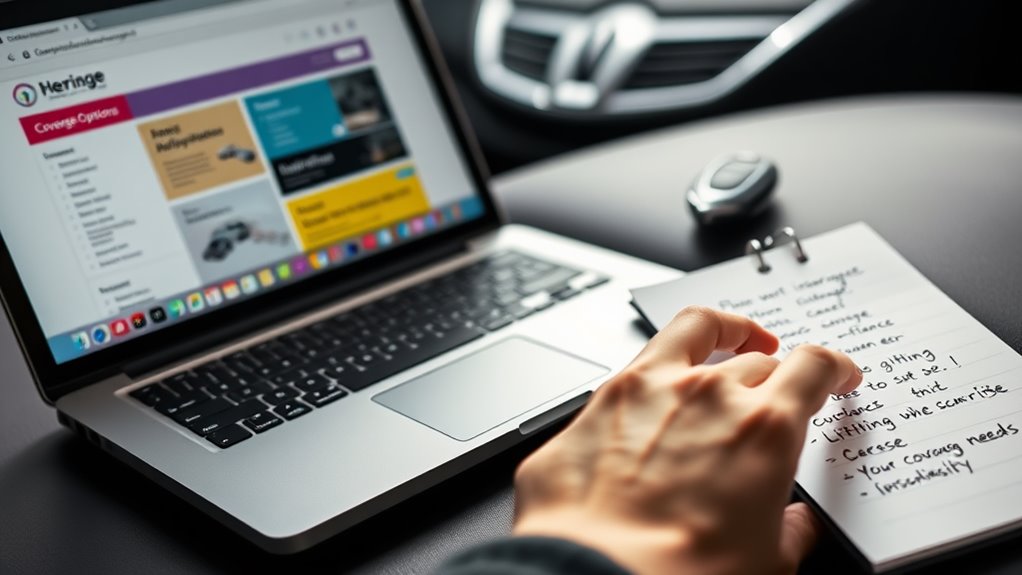Securing temporary car insurance can feel like maneuvering through a maze with no end in sight. But it doesn't have to be overwhelming. By following ten straightforward steps, you can simplify the process and guarantee you have the right coverage for your needs. From evaluating your coverage requirements to understanding your responsibilities as a policyholder, each step is essential for protection on the road. Ready to get started?
Key Takeaways
- Assess your coverage needs, including liability, collision, and any additional options necessary for your driving situation.
- Research temporary insurance options from major insurers and compare quotes using online tools to find the best deal.
- Gather all required documentation, such as personal information, vehicle details, and proof of previous insurance, for a smooth application process.
- Review the terms and conditions of potential policies, including coverage types and exclusions, to ensure they meet your needs.
- Monitor your coverage needs regularly and be proactive about renewing or extending your temporary insurance as necessary.
Assess Your Coverage Needs

When evaluating your coverage needs, how do you determine what's vital for your situation? Start by identifying the types of coverage required. Liability coverage is critical for protecting against damages to others, while collision coverage helps with your vehicle's repairs after an accident. Additionally, consider obtaining non-owner car insurance if you frequently drive vehicles that you do not own.
Consider extensive coverage to guard against theft or natural disasters. You might also want to explore options like uninsured motorist or personal injury protection. Additionally, keep in mind that temporary car insurance provides flexible coverage for a limited period, which is ideal for short-term driving situations.
Don't forget to customize your policy based on your specific needs. Assess the duration of coverage you require—whether it's a day or several months—and confirm your policy meets state minimum requirements.
Finally, gather information about your vehicle and driving eligibility to guarantee a smooth application process.
Research Temporary Insurance Options
How can you find the right temporary insurance option for your needs? Start by understanding that temporary car insurance typically provides coverage for up to six months, ideal for situations where standard policies don't apply.
In the U.S., major insurers usually don't offer options for less than six months, but you can explore alternatives like canceling a regular policy early or opting for pay-per-mile insurance.
If you're driving someone else's car or renting, consider non-owner insurance for liability coverage.
Be cautious of misleading offers claiming daily or weekly insurance, as they may not provide adequate protection.
Research your requirements and evaluate options to guarantee you choose the best fit for your temporary driving needs.
Gather Required Documentation
To secure temporary car insurance, you'll need to gather essential documentation that verifies both your identity and the vehicle's details.
Start with your personal information, including your name, email, phone number, physical address, and driver's license number. Some insurers might also ask for your Social Security number.
Next, obtain vehicle information like the Vehicle Identification Number (VIN), make and model, market value, mileage, and its current condition.
Don't forget to locate required documents such as proof of ownership, the Certificate of European Conformity for imports, and any previous insurance proof.
Finally, consider your policy requirements, including coverage type, duration, and limits.
Having all this documentation ready will streamline the process of securing your temporary car insurance.
Compare Quotes From Different Providers

Comparing quotes from different providers is essential for finding the best temporary car insurance that fits your needs. Start by identifying top insurers like Tempcover, GEICO, and State Farm.
Consider the policy lengths available, as temporary insurance can last anywhere from a few hours to several weeks. Evaluate the coverages offered, ensuring you find extensive options that protect both your vehicle and others.
Use online comparison tools like Compare the Market or The Zebra to streamline the process. Pay attention to financial implications, as quotes can vary greatly based on provider and duration.
Finally, look for policies with no-cancellation fees, which can save you money and hassle if your plans change.
Customize Your Policy
When you're looking for temporary car insurance, customizing your policy to fit your specific needs can make a significant difference in both coverage and cost.
Start by determining the duration you need, as policies can range from one day to several months. Gather your driver's license and vehicle details for an accurate quote.
Determine your needed duration for temporary car insurance, as policies vary from one day to several months.
Assess your coverage needs, ensuring you meet your state's legal requirements—typically, liability coverage is essential. Consider whether you need additional coverages like medical payments.
If you're borrowing a vehicle or renting, review if permissive use might apply to avoid extra policies.
Customizing your policy not only enhances your protection but also keeps costs manageable, ensuring you get the best deal for your situation.
Review the Terms and Conditions
Before you finalize your temporary car insurance, it's crucial to review the terms and conditions carefully.
Start by checking the policy duration, which can range from just an hour to several weeks or months. Make certain you understand the types of coverage included, like liability, collision, and thorough.
Be aware of excluded circumstances—most policies don't cover commercial use, intentional damage, or specific high-risk drivers.
Consider the cost implications, as temporary insurance tends to be pricier per day than traditional options.
Finally, confirm your eligibility criteria, which usually require a valid driver's license and, in some cases, a clean driving record.
Taking these steps guarantees you're well-informed before purchasing your policy.
Purchase the Policy

Once you're familiar with the terms and conditions, it's time to purchase your temporary car insurance policy.
Start by identifying the right provider, as major insurers typically focus on long-term policies. Look into options like pay-per-mile insurance or rental car coverage for short-term needs.
Assess your specific coverage requirements, including liability protection, and tailor the policy to your usage duration. You might consider non-owner insurance if you frequently drive borrowed vehicles.
Evaluate your coverage needs, focusing on liability, and customize your policy based on how long you plan to use the vehicle.
Be cautious with lesser-known insurers to avoid scams. Once you select a policy that fits your needs and budget, complete the application process.
Verify you understand the costs involved, including any potential cancellation fees, before finalizing your purchase.
Receive Proof of Coverage
Receiving proof of coverage is an essential step after purchasing your temporary car insurance policy. You can obtain this proof through various methods.
Many insurers offer online services where you can log in to view or download your insurance card. Mobile apps also provide easy access to digital insurance cards. If you prefer physical documentation, hard copies are available upon request.
For immediate access, contact customer support. You might even request a faxed copy for specific situations.
Your proof of coverage will include important details like your policy number, vehicle information, and insurer details. Make sure to keep this document handy, as it's often required during traffic stops, vehicle registration, and leasing or financing processes.
Understand Your Responsibilities
While you might think temporary car insurance is a straightforward solution, understanding your responsibilities as a policyholder is essential for compliance and protection.
First, verify you meet your state's minimum liability coverage requirements; driving without the proper insurance can lead to serious legal consequences.
You should also familiarize yourself with the types of coverage available, such as liability, extensive, and collision, to select what best suits your needs.
Assess your driving patterns and risks to make informed decisions about the coverage amounts.
Finally, remember that short-term policies often come with cancellation fees, so plan accordingly.
Monitor and Adjust Your Coverage as Needed
Understanding your responsibilities as a policyholder sets the stage for effectively managing your temporary car insurance.
Being an informed policyholder is crucial for successfully managing your temporary car insurance.
Regularly monitoring and adjusting your coverage guarantees it aligns with your current needs. Here are some key points to take into account:
- Review coverage types like liability and collision to match your situation.
- Adjust the coverage period based on your specific driving needs, whether it's a day or a week.
- Utilize comparison tools to find the best rates among providers.
- Consult customer support if you're unsure about the right coverage for your scenario.
- Renew or extend your policy if you require additional coverage beyond the initial term.
Conclusion
Securing temporary car insurance doesn't have to be overwhelming. By evaluating your needs, researching options, and comparing quotes, you can find the right coverage for your situation. Once you gather your documentation and customize your policy, purchasing becomes a straightforward process. Remember, understanding your responsibilities and monitoring your coverage guarantees you stay protected. With a little effort, you'll drive with peace of mind, knowing you've made the right choices for your temporary insurance needs.

